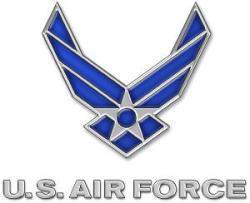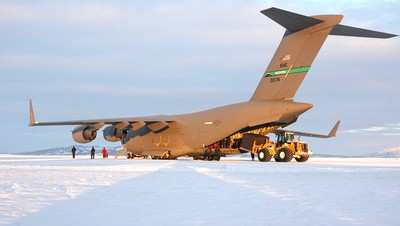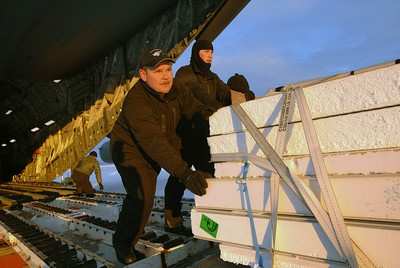 A total force aircrew from McChord
Air Force Base, Wash., made history April 17 during the last
Operation Deep Freeze mission of the 2007-2008 season. With only
eight days remaining before Antarctica becomes shrouded in 24-hour
darkness during winter, Airmen from the 446th and 62nd Airlift
Wings brought 100 scientific researchers, support personnel and
their equipment back to civilization. The mid-April flight is the
closest to winter a Deep Freeze crew has ever landed in
Antarctica.
A total force aircrew from McChord
Air Force Base, Wash., made history April 17 during the last
Operation Deep Freeze mission of the 2007-2008 season. With only
eight days remaining before Antarctica becomes shrouded in 24-hour
darkness during winter, Airmen from the 446th and 62nd Airlift
Wings brought 100 scientific researchers, support personnel and
their equipment back to civilization. The mid-April flight is the
closest to winter a Deep Freeze crew has ever landed in
Antarctica.
Tasked to support the National Science Foundation's research
efforts in Antarctica, the Reserve and active-duty Airmen from
McChord typically provide C-17 Globemaster III support from August
to March, which is summer in the southern hemisphere. However, a
scientific research team from Montana State University required
mission support later than usual this year.
The research team, studying light-driven life in Antarctica's
permanently frozen lakes, had to push their field time as close to
winter as possible in order to have the proper conditions for their
experiments. Unable to receive support this late in the season from
the New Zealand air force, the National Science Foundation called
on the U.S. Air Force for help.
"We knew we could do it. It hasn't happened yet, but if we ever
need to do contingency support -- even in the middle of winter --
we're ready to respond," said Lt. Col. James McGann, commander of
the C-17 Deep Freeze operations and a member of the 62nd AW.
The research would be impossible to conduct without the Air
Force's ability to respond this late in the season, according to
MSU Professor John Priscu. "We wouldn't be here - that's all there
is to it. It's a long way from here to New Zealand," he said. One
of Antarctica's most weathered research scientists, Professor
Priscu has spent 24 seasons on the ice and led this year's MSU
team.

By pushing the season, Professor Priscu believes both the Air
Force and his research team proved something: "It's proof of
concept. We proved we can come down -- and the Air Force can, too
-- and work right up to winter." While most researchers return home
after the summer season, a small support group stays behind at the
NSF station to maintain and build infrastructure. In case something
happens to the support personnel, Colonel McGann is training his
crews to fly into the dark Antarctic winter using night vision
goggles.
"We're ready if they need us. We've flown test flights under
similar circumstances, and although we haven't flown into
Antarctica using NVGs, I'm confident if the call comes, we can do
it safely and expeditiously," he said. Even without the
difficulties inherent in using NVGs, Deep Freeze missions have more
than their share of risks.
Landing on an ice runway in temperatures as frigid as -70
degrees Fahrenheit, Operation Deep Freeze is one of Air Mobility
Command's most extreme missions. As such, Colonel McGann
cherry-picks his crew, exploiting the expertise of both Reserve and
active-duty Airmen from McChord AFB.
"Without a doubt, it's one of the most sought-after missions to
get on in Air Mobility Command," said Maj. Tom Jenkins, deputy
commander of the mission and a Reserve pilot from the 446th AW.
Fewer than 20 pilots in the entire command are certified to fly
Deep Freeze missions, and the process takes three years to
complete. Aside from landing on a giant sheet of ice, unpredictable
weather makes Antarctica one of the most difficult places to fly
into in the world.
"[The weather] can change in a second. Even on a sunny day, if
that wind picks up, it blows the snow everywhere. On another
mission I was on, you couldn't see more than 50 feet just from the
wind blowing the snow around," said Maj. Chuck Corrigan, A Reserve
pilot and one-of-two pilots who were certified on the mission.
The bitter temperatures have a profound affect as well on
loadmasters and crew chiefs, who are forced to work in the
elements. After cargo is loaded onto the C-17 using giant
forklifts, loadmasters have to push the pallets into place by hand
and secure them, all without any heat on the airplane. If something
breaks during flight and needs to be fixed after landing, crew
chiefs have to respond to the situation, no matter how inhospitable
the temperature is outside.
"The hardest part is working with your hands, because they get
cold very fast. Fortunately, we didn't have any maintenance issues
this time," Tech. Sgt. Michelle Short, a Deep Freeze crew chief
from the 62nd Aircraft Maintenance Squadron.
At least for loadmasters, conditions have improved a bit over
the years. Master Sgt. Terry Philon, a Reserve loadmaster from the
446th AW, has flown to Antarctica in both C-17s and its
predecessor, the C-141 Starlifter. Sergeant Philon is one of the
most experienced members of the crew, having just completed his
16th Deep Freeze trip since he began flying them in 1999.
"It's a world of difference between those two planes," he said.
"In the (C-)141, it got cold and stayed cold. Since the ceiling
wasn't as high (as the C-17), you had space limitations, too. The
first time I flew, I configured the jet and realized that I was
stuck in the back, with no way to get up front. Luckily, you don't
have to worry about that with the C-17."
Another person thankful for the C-17's extended capabilities is
Professor Priscu, who was able to avoid spending the winter in
Antarctica thanks to the plane's increased cargo and passenger
capacities.

"People were frothing at the mouth when we found out a C-17 was
coming," he said. "Some of them have been here since last winter
and they're starting to act a bit weird. They're definitely ready
to get out." Thanks to the expertise of Deep Freeze Reserve and
active-duty Airmen, and the capabilities of the C-17, Professor
Priscu and his crew were able to escape back to civilization before
things got too weird. [ANN Salutes Tech. Sgt. Nick Przybyciel,
446th Airlift Wing Public Affairs]
 ANN's Daily Aero-Term (05.05.25): Circle To Runway (Runway Number)
ANN's Daily Aero-Term (05.05.25): Circle To Runway (Runway Number) ANN's Daily Aero-Linx (05.05.25)
ANN's Daily Aero-Linx (05.05.25) NTSB Prelim: De Havilland DHC-1
NTSB Prelim: De Havilland DHC-1 Classic Aero-TV: The Boeing Dreamliner -- Historic First Flight Coverage
Classic Aero-TV: The Boeing Dreamliner -- Historic First Flight Coverage Airborne-NextGen 05.06.25: AF Uncrewed Fighters, Drones v Planes, Joby Crew Test
Airborne-NextGen 05.06.25: AF Uncrewed Fighters, Drones v Planes, Joby Crew Test





